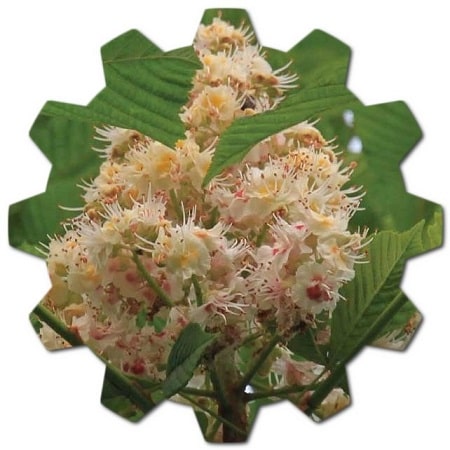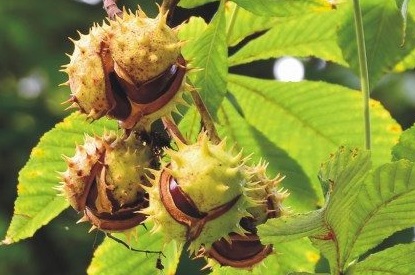The English name for Aesculus hippocastanum is Horse Chestnut. Horse chestnut is a deciduous tree known for its distinctive palmate leaves and large, round fruits often referred to as conkers. These trees are commonly planted in parks and urban areas for their shade and ornamental value.
Information about Aesculus hippocastanum; Aesculus hippocastanum, commonly known as Horse Chestnut, is a deciduous tree native to southeastern Europe. It is widely cultivated in various parts of the world for its attractive appearance, large, distinctive leaves, and unique fruits. Here is some information about Aesculus hippocastanum:

1. Appearance:
- Leaves: Horse chestnut trees have palmately compound leaves, typically consisting of five to seven individual leaflets with serrated edges. The leaves are large and dark green in color.
- Flowers: In late spring to early summer, the tree produces pyramid-shaped clusters of white to pinkish-white, attractive, and mildly fragrant flowers. Each individual flower has four or five petals.
- Fruit: The tree’s fruit is a spiky capsule or husk known as a conker. Inside the capsule, there is a shiny, dark brown nut. Conkers are not edible, and the tree should not be confused with edible chestnuts (genus Castanea).
2. Size:
- Horse chestnut trees are medium to large in size, typically reaching heights of 50 to 75 feet (15 to 23 meters) or more when mature.
3. Location:
- The horse chestnut tree is native to the Balkan Peninsula in southeastern Europe but has been widely planted as an ornamental tree in various regions worldwide. It is commonly found in parks, gardens, and along streets.
4. Uses:
- Horse chestnut trees are primarily planted for ornamental purposes due to their attractive foliage and flowers. They provide shade and beauty to urban and suburban landscapes.
- The wood of the horse chestnut tree is not highly valuable for timber but is sometimes used for small woodworking projects.
- Historically, various parts of the horse chestnut tree have been used in traditional medicine for their purported medicinal properties, but these uses are not widely accepted today.
5. Toxicity:
- The seeds (conkers) and other parts of the horse chestnut tree contain a compound called aesculin, which is toxic to humans and animals if ingested. The seeds should not be consumed.
6. Conservation Status:
- Aesculus hippocastanum is not considered endangered or threatened and is widely cultivated for ornamental purposes.
7. Cultural Significance:
- The game of conkers, in which children attempt to break each other’s conkers by striking them with another conker on a string, is a traditional British and Irish pastime associated with horse chestnuts.
Horse chestnut trees are admired for their beautiful appearance and make lovely additions to gardens and public spaces. While the seeds are toxic, the tree itself is prized for its aesthetic qualities, and its springtime blossoms are a welcome sight in many landscapes.
Where is the Aesculus hippocastanum tree native?
Aesculus hippocastanum, commonly known as Horse Chestnut, is native to southeastern Europe, specifically the Balkan Peninsula. This region includes parts of present-day countries such as Albania, Bulgaria, Greece, and the western area of the former Yugoslavia. In its native habitat, Horse Chestnut trees can be found growing in woodlands and forests, typically in mountainous or hilly terrain.

While native to southeastern Europe, Horse Chestnut has been widely cultivated and introduced to various parts of the world for its ornamental and shade-providing qualities. It is commonly planted in parks, gardens, and urban areas in many temperate regions, where it has become a familiar and cherished tree.
